#seax knife
Explore tagged Tumblr posts
Text

This handmade masterpiece, a finely crafted sword, is a true reflection of Nepal's rich cultural significance and heritage. Every aspect of the sword, from its meticulously forged blade to its intricately designed handle, showcases the unique artistry of Nepali craftsmanship. The sword’s design draws inspiration from the country's deep-rooted traditions and iconic landmarks, capturing the essence of Nepal in its form. When displayed as a decorative piece, it adds a touch of elegance and history to any home, serving not only as a beautiful ornament but also as a symbol of the uniqueness and cultural depth of Nepal. This sword is more than just decor; it’s a celebration of Nepal's enduring legacy. Features: • Renowned Traditional Sword: A nod to Viking history. • Hand-Forged in Nepal: Crafted using time-honored methods. • Nepalese Craftsmanship: Handmade with precision and care. • Rosewood Handle: 9.5 inches full tang for a sturdy grip. • Scabbard: Made of cottonwood, wrapped in leather for a classic look. • Blade: 21 inches long, forged from 5160 leaf spring steel. • Weight: Blade alone weighs 1616 grams (3.5 Pound). • Total Weight: 1996 grams (4.4 Pound) including the blade and scabbard.
0 notes
Text

Seax
Seax. Visit: https://noblie.eu/wp-content/uploads/2024/05/seax.jpeg
1 note
·
View note
Text
@nimblermortal sent me this last week:
A second blade weapon became increasingly common in the later Viking Age. It does not have a formal name, being often referred to as a fighting-knife or battle-knife, and it was essentially a development of the one-handed, long seax knife of the Migration Period. A single-edged blade with a thick back that added weight to a short, stabbing blow, it seems to have been intended as a back-up weapon. By the tenth century, battle-knives had elaborate scabbards that were worn horizontally along the belt, allowing them to be drawn across the body from behind a shield if the sword was gone; a variant hung down at an angle from an elaborate harness. It seems they may also have been worn on the back - again for a swift, over-the-shoulder draw. Children of Ash and Elm by Neil Price @petermorwood (Mr Morwood! Mr Morwood!) I found an archaeologist claiming people were doing over-the-shoulder draws! Would you care to weigh in?
*****
Would I ever! That's a button well pushed. But things got odd when I tried, because as soon as I'd written even the smallest reply and saved to Draft, this happened:
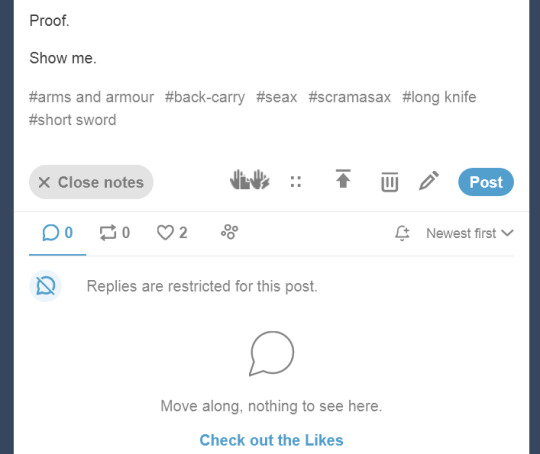
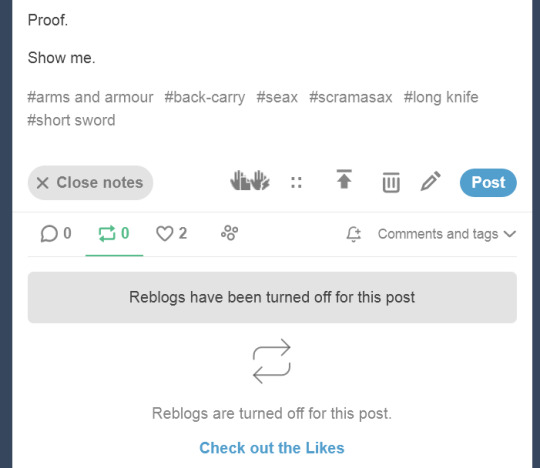
Letting it stand would have seemed like I was trying to avoid comments, corrections or criticism, but despite poking around in Settings there was no way to turn things on. It was only by cut-and-pasting @nimblermortal's entire original as a Quote starting a new post that the problem was resolved.
Anyone else encountered this?
Anyway, on with the lecture response. :->
*****
As regards Back-Carry / Back-Draw of "battle-knives", I'm not convinced.
("Battle-knife" is a term I've never seen in connection with any Viking Age weapon. What's the Old Norse for it? German "Kriegsmesser" (war-knife) refers to something much bigger from 500 years later, also not back-carried or back-drawn - which from here on will be BD / BC.)
To get where he is now, a full professor, Neil Price will have defended his PhD, and should know such a statement as "It seems they may..." will need evidence to support it.
That phrase is easy to write, as is "According to legend..." and "It is said..." However these are IMO default History Channel phrases, with all the authenticity that implies. None of them actually PROVE what they're speculating.
"Experiments conducted by museum staff wearing authentic armour reveal that IT SEEMS medieval knights could use smartphones."
But does it prove medieval knights USED smartphones? See what I mean?
*****
I first asked if anyone had actual proof of BC / BD on Netsword almost 30 years ago, and to date there's been nothing. I've also posted about it quite a lot on Tumblr, so being poked with this particular stick is no surprise. :->
The quotation from "Children of Ash and Elm" is the first time I've heard of a trained archaeologist making a claim for BC / BD, and the odd part is that Prof. Price also states the weapon was intended for "...a short, stabbing blow" - which means wearing it horizontally in front makes far more sense. From that position it can be drawn far faster and with less telegraphed intent than "...on the back - again for a swift, over-the-shoulder draw."
Reaching up for any weapon carried across the back, whether long or short, is a bigger movement - and thus less "swift" - than snatching out the same weapon worn at the hip or across the front at waist level, especially if - as he suggests - that move is masked behind a shield (or for that matter a cloak, a door, or a half-turned torso...)
Try both moves in front of a mirror with a ruler or even a length of dowel, and you'll understand.
With a weapon-hilt visible behind one shoulder or just a cross-belt suggesting something slung out of sight, what's a Norse warrior going to think when his potential opponent reaches up there? At a moment of hot words and high tension, will he wait while an itchy back gets scratched or until an attack happens?
The explosive violence described in sagas suggests not.
If Prof. Price has solid proof for his BC / BD notion in the form of artefacts or art - and it'll need more than a one-off example - I'll be very pleased to finally see some "show me" evidence.
(It won't do anything for longswords of 500 years later, of course, though I bet the uncritical back-carry brigade would leap on it regardless.)
But without that evidence, I'm taking "it seems" with a wary pinch of salt.
*****
There's a weird internet fixation about BC / BD (which are NOT the same thing) and an equally weird need to show that back-draw "works", whether with hooks under the guard and a leather condom at the point...
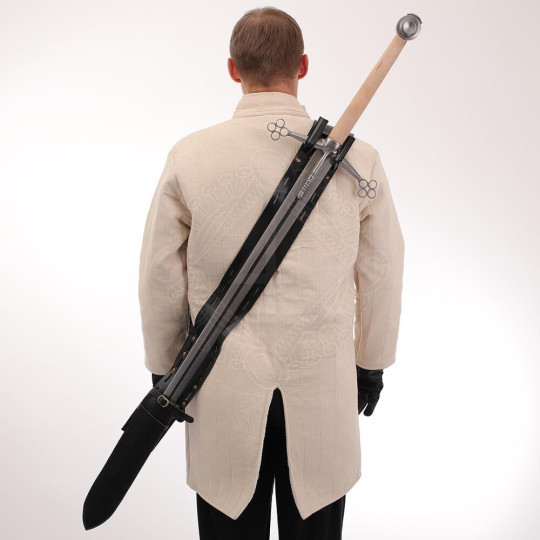
... or by being open most of the way down one side.
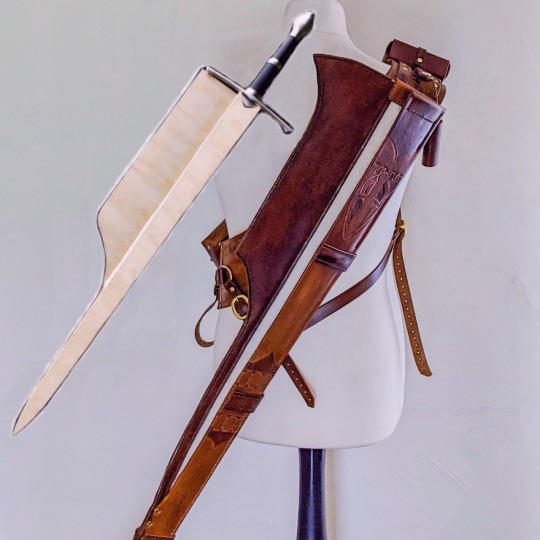
Neither are real-world historical, so let's see how they work in fantasy.
IMO they're not appropriate there either, because the designers are so eager to provide working BC / BD that they ignore the main function of a scabbard, which is to carry the weapon in something which protects people from the weapon's edges, and the weapon from the elements.
Real scabbards for real swords went to some trouble over that. They protected people, including the wearer, with a completely enclosed wooden, leather and / or metal case, and protected the blades by having them fit into their case well enough that inclement weather stayed out.
This fitting could involve metal collars (Japanese habaki), or tight-gripping lanolin-rich fleece linings, or leather flaps, caps and rain-guards mounted on hilt or scabbard-throat. Real scabbards didn't have exposed metal and weren't open-sided rainfall buckets, because the priorities of actual sword users were very different to those of back-carry fans.
Given the number of posts I've seen about the technical side of fantasy world-building - history, geography, even geology and meteorology - I think this difference is worth noting.
*****
The first time I recall seeing back-carry mentioned in a historical-not-fantasy context was in "Growing Up in the Thirteenth Century", © Alfred Duggan 1962. Here's the extract in question:
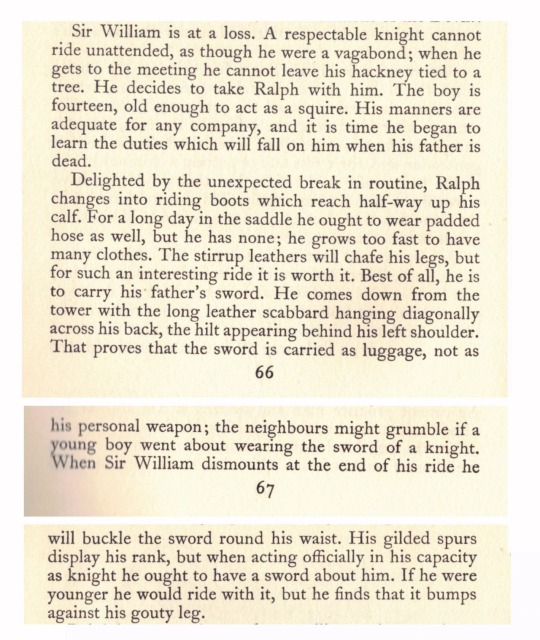
Unfortunately Duggan - though according to his Wikipedia entry "His novels are known for meticulous historical research" - doesn't give any cited source for this; his introduction to the book says:

I know the feeling! :->
I'd still trust him more than some modern historical writers who seem over-willing to add a touch of fantasy speculation / interpretation if it rounds out something inconclusive, makes the history more interesting or chimes with a personal agenda.
"Accurate" is better than "interesting", and "I don't know" is better than making stuff up.
*****
To repeat: I've yet to see any museum-exhibit or manuscript-illumination examples of BC / BD ever done For Historically Real with Western European swords, especially the hand-and-a-half longswords on which modern back-draw fans seem fixated.
A seax, scramasax or just plan sax is shorter, but yet again, this is the first time I've read anything even remotely scholarly about them or their later Viking-age version (saxes were associated more with Saxons than Vikings, guess why?) being BC / BD.
By contrast, there are at least three art instances of saxes worn horizontally, on 10th century crosses at Middleton Church, Yorkshire:

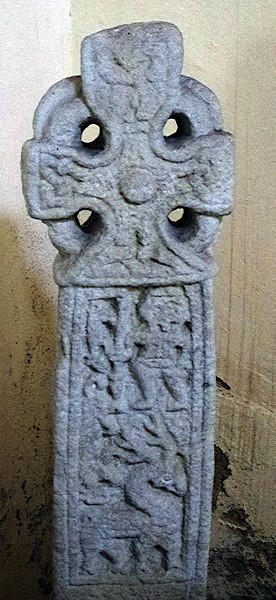

The art is backed up by surviving examples with scabbard-fittings still in place, indicating how they were worn. Here's one example, from the Metropolitan Museum, New York which makes that very obvious.
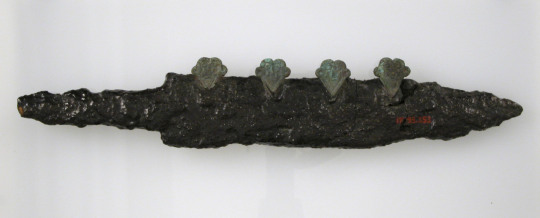
The little decorative masks (originally part of the top of the scabbard, now corroded onto the blade) are clearly meant to be This Side Up, and also show that this scabbard was This Side Out for a right-handed draw, since there's no detail on the back.
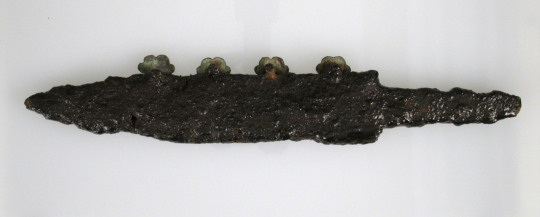
There's a similar fancy-front / plain-back / right-hand-use leather sax scabbard at the Jorvik Centre in York.
There's only a single photograph of this bigger one - 54cm (21.5 in) overall - from the Cleveland Museum of Art, with no way to see if the L-shaped scabbard mount is decorated on just one or both sides. However it does indicate the weapon was meant for horizontal wear.
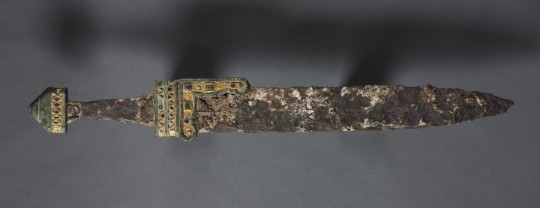
I've also flipped the website photo to show right-hand use, because "It seems..." (hah!) more probable. Here's why I did it:
For most of history being left-handed was unusual, a disapproved-of aberration and the origin of the word sinister.
Left-handers were useless in any formation from Ancient Greece through Ancient Rome to the Saxon and Viking period where the shields of a phalanx, testudo or shield-wall had to overlap for mutual support.
In the Middle Ages, both the specialised armour and the layout of jousting courses were almost 100% right-hand only.
Most surviving swords with asymmetrical hilts, such as swept-hilt rapiers, are made to for right hands not left.
Even nowadays many weapons - including the current British Army rifle (SA-80 / L85/A2) - are set for right-handers only.
*****
The longest saxes are called Langseax (surprise) though this may be a modern-ish term. Here's one from the British Museum, the so-called "Seax of Beagnoth"...

...which is 72 cm (28.5 in) total / 55cm (22 in) blade.
That's about the same as a Roman gladius (another sword never back-worn despite its convenient size) and is a good 25-30cm (10-12 in) shorter than the average "proper" sword of the same period, which means it could be drawn over-shoulder...
However the layout of its runic engraving shows it was almost certainly meant to be worn horizontally As Per Usual.
*****
And now we've come all the way back around to Prof. Price's claim that Vikings did BC / BD with their battle-knives.
Such a claim needs proof.
Please, show me some.
#arms and armour#back-carry#seax#scramasax#long knife#short sword#left-handed weapons#research#evidence
81 notes
·
View notes
Text
Round 4, Seax 7 / 10
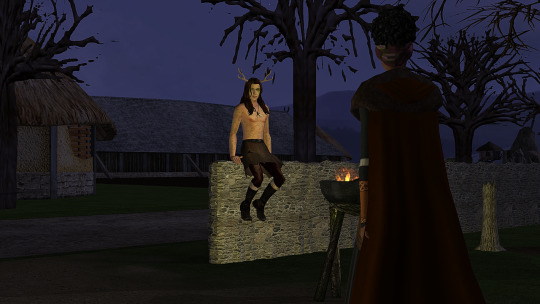
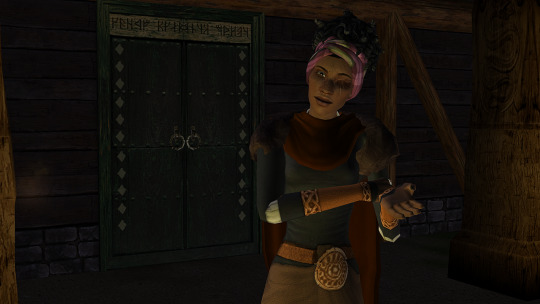
Norweni: Ah. It's you.
Arturo: Lady Knife. I understand that I was summoned?
Norweni: I told Elmet to ask if you would come speak with me. Several days ago.
Arturo: First the little witch, now this one thinks she can summon me at will too.

Norweni: You didn't want to come. Or is it that you couldn't? Helenet says you have some sort of magical condition.
Arturo: …
Norweni: I see.
Arturo: Is this where you attempt to run me out of town?
Norweni: If I were to do that, there would be significantly more people with weapons here. Perhaps a magician, if I could find one that isn't infatuated with you. My grandmother told us plenty of tales about the fae.

Arturo: I'm not one of the fae. The fae are arseholes.

Norweni: Well, on that, we agree. I asked you here because I want to know more about you. You are living in the town I'm responsible for, after all.
Arturo: You hardly own the forest. But I will strike you a bargain. A question for a question.

Norweni: Hm. Very well... where were you born?
Arturo: Here.
Norweni: In Veridia?
Arturo: That's two questions. But yes. I don't remember what its name was then, only that to me, the valley is home. My turn now. How did you lose an eye?

Norweni: …A bar fight.

Arturo: Oh, you don't like telling people that, do you? No, no, it doesn't make for a very noble story.
Norweni: It makes for an embarrassing story. Most people aren't rude enough to ask about it.

Norweni: What are you, if not a faery?
Arturo: I don't know.
Norweni: It's hardly a bargain if you refuse to answer.

Arturo: If I knew, I might have fewer problems.
Norweni: I don't know. You'd probably still have Elmet.
Arturo: Yes, yes, Lady Knife, very funny.

She really doesn't like him, guys. The feeling is mutual!
#he's calling her Lady Knife because a seax is a type of large knife/short sword#also she's probably got at least two knives on her#TS2#eulalia: Veridia#sims: Norweni#sims: Arturo
22 notes
·
View notes
Text
Remember to lubricate
Or else you'll have

0 notes
Text
everyone STILL grieving the GOs2 finale and I've been here absolutely chomping at the proverbial bit to stab the Metatron with a 5th century Seax and die trying since the millisecond the credits ended
Neil partnered with the fucking HILLYWOOD SHOW.
"HAIL HILLYWOOD HAIL GAIMAN" was about the FUCKING METATRON
how is nobody else's gut reaction "Unspeakable Knife Violence"
#yall ive got some news Cain IS canon in Good Omens like nothings stopping us#its literally the Gay Angel x Gay Demon show like cmon the door is not going to get any wider open#well i mean except *stares directly at Muriel* buttttt thats a problem for s3#Grendelposting#the Gaimanverse IS more myth-based and just trust me that a Seax is the traiditional knife for the Descendants of Cain#options for that are a) Seax or b) bare hands and teeth
1 note
·
View note
Text
I haven't really had the brain space to do much translation lately, but I just did a little presentation for a classics department event on one of my favorite old english texts that I thought you guys might enjoy :) this is a little magical charm to help get rid of cramps by telling evil spirits to stop poking you with their spears and arrows. the herbs it mentions are all medicinal! (waybread refers to broadleaf plantain, a little leafy weed, not the banana relative) here's the old english text, then my own translation:
Wið færstice feferfuige and seo reade netele, ðe þurh ærn inwyxð, and wegbrade; wyll in buteran.
Hlude wæran hy, la, hlude, ða hy ofer þone hlæw ridan. Wæran anmode, ða hy ofer land ridan. Scyld ðu ðe nu, þu ðysne nið genesan mote. Ut, lytel spere, gif her inne sie. Stod under linde, under leohtum scylde þær ða mihtigan wif hyra mægen beræddon and hy gyllende garas sændan. Ic him oðerne oft wille sændan, fleogende flan forane togeanes. Ut lyte spere, gif hit her innes sy. Sæt smið sloh seax, lytel iserna wund swiðe. Ut lytel spere, gif her inne sy. Syx smiðas sætan wælspera worhtan. Ut, spere! Næs in, spere! Gif her inne sy isenes dæl Hægtessan geweorc hit sceal gemyltan. Gif ðu wære on fell scoten oððe wære on flæsc scoten oððe wære on blod scoten oððe wære on lið scoten, næfre ne sy ðin lif atæsed. Gif hit wære esa gescot oððe hit wære ylfa gescot oððe hit wære hægtessan gescot, nu ic wille ðin helpan. Þis ðe to bote esa gescotes, ðis ðe to bote ylfa gescotas, ðis ðe to bote hægessan gescotes, ic ðin wille helpan. Fled þær on fyrgen hæfde. Hal westu! Helpe ðin drihten!
Nim þonne þæt seax, ado on wætan.
Against a stitch: feverfew and the red nettle, that which grows throughout a secret place, and waybread (plantain); boil in butter
They were loud, lo, loud, they who rode over the mound. They were steadfast, they who rode over the land. Shield yourself now, so you might escape this evil. Out, little spear, if you are inside here! He stood under the lindens, under a light shield, where the mighty women deprive their power and send forth yelling spears. I wish to send them another one soon, a dart flying before the opposition. Out, little spear, if you are inside here! A smith sat, striking a knife, little, iron, so wonderful. Out, little spear, if you are inside here! Six smiths sat, working a death-spear. Out, spear! Not in, spear! If it is in here, a piece of iron, the work of a hag, it must melt. If you were shot in the skin or were shot in the flesh or were shot in the blood or were shot in the limb, may your life never be torn. If it were shot by gods or if it were shot by elves or it were shot by hags, I will now help you. This for you as a remedy for the shot of gods, this for you as a remedy for the shot of elves This for you as a remedy for the shot of hags. I will now help you. It has fled there onto the mountain. Be healthy! May the Lord help you!
Then take that knife, banish it into the water.
72 notes
·
View notes
Text
Bjornsson

Full Name: Bjornsson (Son of Bjorn)
Alias(es): The Wolf of the North, Ragnar’s Shadow, The Unyielding
Age: 32
Gender: Male
Occupation: Viking Chieftain, Raider, Warlord
Affiliation: His clan (Name TBD)
Status: Alive
Family:
Bjorn the Red (Father, deceased) – Former chieftain, a ruthless warrior known for his bloody conquests.
Astrid (Mother, unknown fate) – A seeress who disappeared when Bjornsson was a child.
Half-siblings (Unacknowledged) – As is common in Viking culture, Bjornsson likely has half-siblings from his father’s various concubines or wives, but he does not acknowledge them.
Appearance
Bjornsson is an imposing warrior, standing well over six feet tall, his body carved from years of battle. His long, dark blonde hair is braided back, streaked with hints of silver at the temples. His piercing ice-blue eyes are his most striking feature, cold and calculating, though they burn with something darker when fixated on YN.
A deep scar runs from his left temple to his jawline, a mark from an ambush during his youth. He wears hardened leather and chainmail, often draped in wolf pelts, signifying his status as a hunter and a leader. His arms and chest are marked with runic tattoos, symbols of protection, war, and fate.
Personality
Bjornsson is a man of contradictions. He is both calculated and impulsive, brutal yet strangely protective. His leadership is rooted in strength and fear, but he commands loyalty from his people because he is undeniably effective.
Cold & Possessive: He is not used to losing anything, let alone someone he desires. YN’s resistance only fuels his obsession.
Respected, but Feared: His people follow him not just out of loyalty, but because crossing him is dangerous.
Tactical Mind: He is a strategist, always five steps ahead, which makes escape nearly impossible.
Believes in Fate: His mother was a seeress, and though he denies believing in magic, YN’s survival against the wolf unnerves him. He sees it as a sign from the gods.
Backstory
Bjornsson was raised in the shadow of Bjorn the Red, a warlord who saw compassion as weakness. From an early age, he was trained to fight, kill, and lead.
His first kill was at age 12, when he slaughtered a rival chieftain’s son during a raid.
At 15, he was sent into the wilderness alone as a test of manhood. He killed a massive wolf with nothing but a seax knife, earning his title as The Wolf of the North.
By 20, he had claimed his father’s title, after Bjorn the Red was betrayed and killed. Bjornsson hunted down every man involved and executed them brutally.
Despite his upbringing, Bjornsson does not enjoy pointless cruelty. He is a man of war, not madness.
Past Relationships
Bjornsson has had lovers, concubines, and women offered to him, but he has never claimed anyone as his own.
Casual Affairs: He has shared beds with women out of convenience, but none have held his interest.
Marriage Prospects: He has rejected several marriage alliances, finding no woman worthy.
Why YN is Different: She is not given to him, not easy, and not afraid. She fought back. And she made a choice—to save her village—rather than be taken like a victim.
This intrigues him. This angers him. And more than anything, this makes him want her even more.
Obsession with YN
Bjornsson’s fixation on YN is different from any desire he has felt before.
The First Spark: When she wounded him during the raid, he felt shock—then excitement. A simple village girl drew his blood.
The Breaking Point: When she agreed to go willingly to save her people, it twisted something inside him. She did not beg. She did not plead. She chose.
His Logic: If the gods willed her survival, then she must belong to him.
Her defiance makes him restless. Her resistance thrills him. He adores her fire but will break her if necessary.
Life in the Settlement
YN’s arrival is met with curiosity, envy, and resentment.
The Women’s Reactions: Some resent her for holding Bjornsson’s attention, while others seek to befriend her to understand why.
The Warriors’ Reactions: His men mock him for being "soft" over a village girl—until they realize she is no ordinary woman.
The Völva’s Interest: The village seeress (Völva) is fascinated by YN’s knowledge of herbs. She claims fate brought her here.
Bjornsson relishes her struggles yet protects her fiercely. Any man who so much as looks at her too long meets a swift, brutal fate.
Trivia
He has never lost a battle.
The wolf pelts he wears are symbolic, a reminder of his first kill.
He carves runes into his weapons before battle.
He believes YN belongs to him completely—body, soul, and fate.
#yandere x darling#yandere x you#yandere x reader#yandere x y/n#yandere oc#yandere x mc#yandere#yandere ocs#yandere male x reader#yandere male x you
36 notes
·
View notes
Text

Anglo Saxon Seax
Anglo Saxon Seax. Visit: https://noblie.eu/wp-content/uploads/2024/05/anglo-saxon-seax.jpeg
2 notes
·
View notes
Text


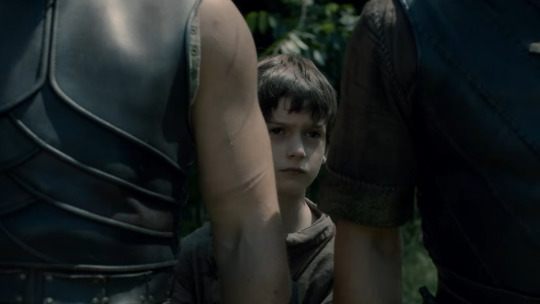
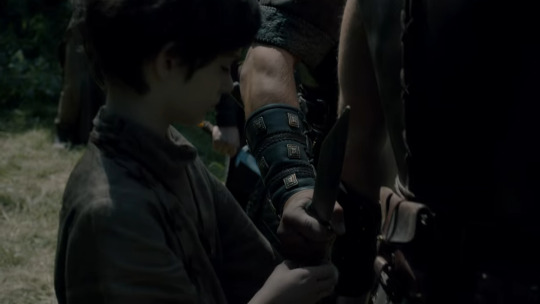

this is so fucking sweet. and seeing the different ways the 3 of them show their protectiveness is gorgeous. Especially Sihtric saying he wants the seax back. Like not to be deep, but reassuring him "we're about to go into a scary fight and you will need to both run and defend yourself but listen here i will see you again and i want my fucking knife back okay kid?"
that's adorable
#the last kingdom#liveblogging tag#finan#uhtred#sihtric#uhtred's pretty boys#fintred#fintric#aethelstan#tlk s4e6
289 notes
·
View notes
Text
Round 4, Seax 4 / 10

Norweni: Now that you're both here—Gytha, we have a proposal for you.
Gytha: Uhhh, am I in trouble?
Norweni: No. Shep?
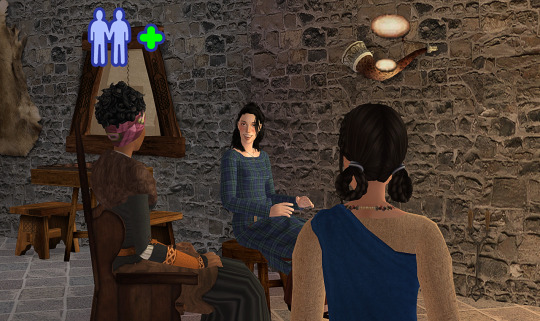
Shep: I was explaining to Norweni recently that I wanna start making more pottery—
Norweni: It'd be good for the market.
Shep: Yeah, yeah. But it's a lot on top of keeping up with the bees and my wheat fields in spring, so she suggested I take on an apprentice of sorts, and I know you're creatively inclined!

Norweni: Gytha, what do you think?
Gytha: Yes! I would love to do that!
Norweni: Excellent. To make things easier, I think you probably ought to come stay in town in the spring, either with Shep or here in the hall with Diseta and I. We'll work it out soon.

Gytha: Thankyouthankyouthankyou!
Shep: Oof! Haha, you better be prepared to work, kid!
Gytha: I will get SO good at making pottery and, uh... bees?
Shep: Bees are mine. No offense.

Gytha: I can weave too! Pretty well. Just so you know.
Norweni: I'm sure someone could use help with that after shearing season, if you want to pick up the extra work.


Job done, time to go look badass while hitting things.

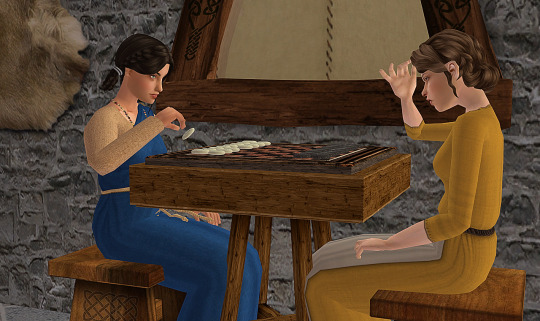
Gytha hung around after Shep left to play a game or two with Enna. She's trying to teach her friend how to play riverstones, but the rules are a bit arcane.
Enna: So that marking can go across stones, but that other marking can't? But why?
Gytha: Because that's the rules, I guess?
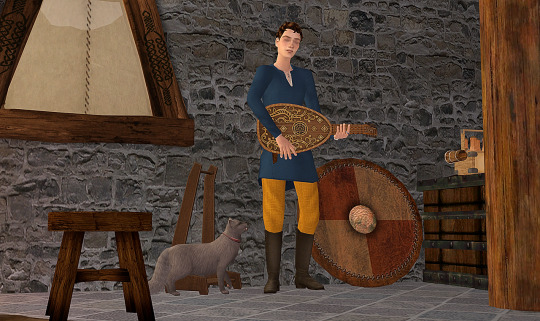

Lu likes to sing along with Diseta's lute. Together they make a beautiful cacophony.
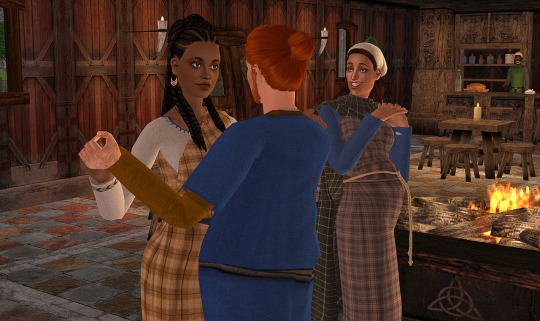
Same, Helenet, same.
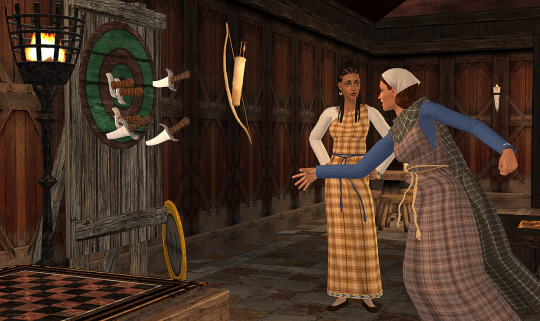
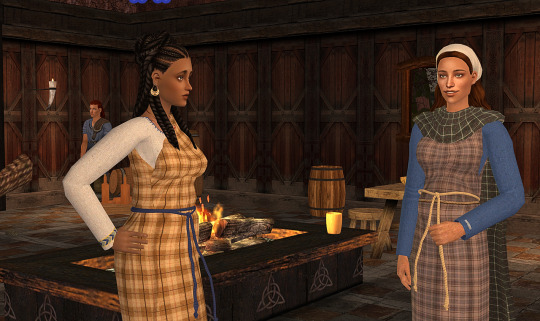
Fial: Is knife-throwing during pregnancy recommended?
Helenet: I mean, the baby is inside, not in front of the board.


Enna: You're my boyfriend, aren't you s'posed to let me win sometimes?
Glamaer: I don't think that's a rule? Anyway, how would you get better at it that way?
Enna: Through the satisfaction of winning.
Glamaer: I'm not sure that's how it works.
#TS2#eulalia: Veridia#sims: Norweni#sims: Diseta#sims: Sun#sims: Enna#sims: Shep#sims: Gytha#sims: Glamaer#sims: Fial#sims: Helenet#pets: Lu
21 notes
·
View notes
Text

When Uhtred leaves Sihtric’s longhouse, he stands outside for a moment as the gravity of everything crashes down on him. He feels like he can’t breathe, and his heart won’t stop racing in his chest. If Gisela had sought to break him, she has succeeded. He glances forlornly at Finan’s cottage. He knows he should go back there, but he can’t quite bring himself to do it. Stiorra is safe with Sihtric, and that’s all that matters right now. He looks over at the alehouse, candle light flickering in the windows and the sounds of men laughing and talking echoing outside.
Without giving it anymore thought, Uhtred strides in that direction. Determination in him to drown out what he’s feeling. To dull this ache in his chest, feeling like there is still a knife lodged in it. When he enters the alehouse, he orders himself a drink and finds a table in a dark corner, away from the other patrons. Thoughts of the life he and Gisela once had flood his mind. The love he had for her. The life he wanted to have with her.
When he finishes his first mug of ale, he orders another one. His thoughts turning to the last several months with Gisela. Seeing hints of her betrayal in her behavior. How did he not see it? How could he be so blind? The words of their argument flow into his mind playing on repeat. You killed my husband, Uhtred… You have killed the person who saved me, all for your beloved Irish whore… I traded him for you…
The rage at those words bubbles back to the surface. Finishing the last bit of ale in his mug, Uhtred tosses some coins on the table before leaving the alehouse. Everyone quickly making a path for him, seeing the fury on his face. He strides to the Great Hall, climbing the steps quickly before he pushes open the door. Seeing the dishes on the floor that she tried to throw at him, proving to him that this all wasn’t just a bad dream, this really happened.
Running up the stairs to the loft, Uhtred enters their bed chambers. He needs her out of here. He needs her to be gone. Ripping open the doors to their wardrobe, he pulls out all of her gowns and garments. Carrying them to the railing of the loft and throwing them down. All of her jewelry, her combs, anything that belongs to her he throws over the railing to a pile in the main hall. It’s not enough. He can still feel the rage coursing through him. He rips off the furs from their bed. He knocks over the tables in their room causing the contents to be strewn across the floor. He brings down the wardrobe, letting it crash to the floor. When he finally stops the room is in shambles…and so is he.
The dam breaks inside of him. He looks over the railing at his sword and seax laying on the long table. So close, yet so far away. He turns back into the room, stumbling over the stuff strewn all over the floor, his eyes blinded by tears. He sits on the floor in a dark corner of the room, as sobs rack his body. His arms crossed over his knees as he rests his forehead on them. I have caused my family so much pain…This is all my fault…I should have known…
@thedarkprinceofulaid @asksihtrickjartansen @warriorabbesshild
#the last kingdom#tlk fandom#uhtred of bebbanburg#tlk rp#askuhtredragnarson#uhtred#uhtred ragnarson#tlk uhtred
14 notes
·
View notes
Text
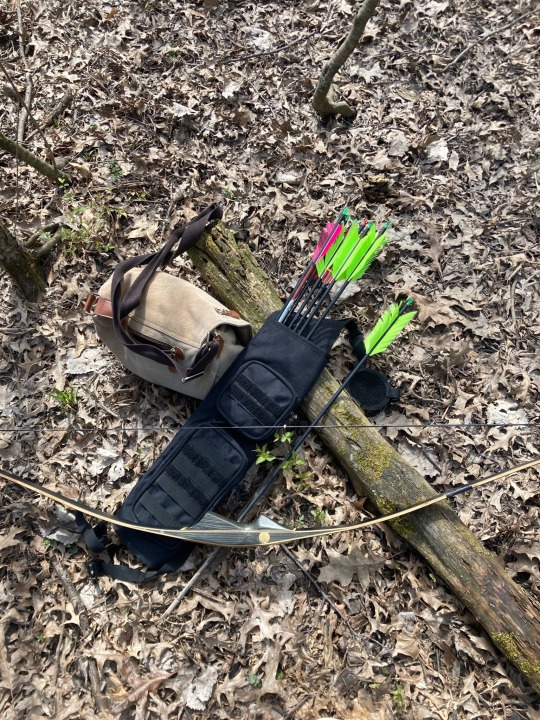
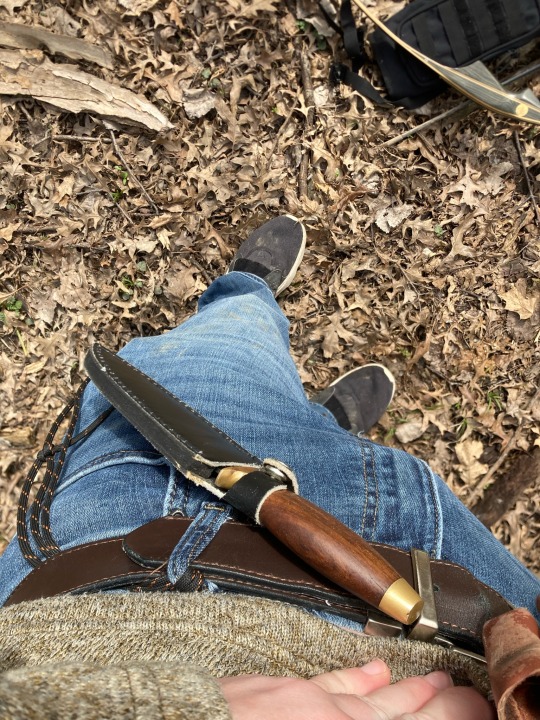

I’m basically a ranger. Yeah sure I don’t have the hot cloak, or a seaxe and throwing knife- but like, I can do it until I get it right and uh- uh- I can stalk a rabbit! Im ready for my silver oak leaf, please daddy Gilan, make Will take me under his wing.
#rangercore#gilan davidson#fantasy#rangers apprentice#medieval#i love archery#archery#dnd#woods#roving#longbow
43 notes
·
View notes
Text
Sax
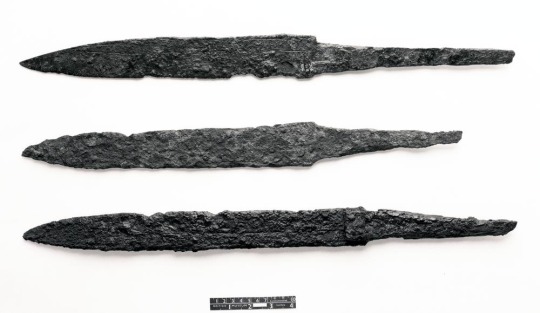
A sax or seax is a bladed weapon which is sized between a knife and sword. There are many varieties of sax weapons, both in handles and their decoration and the blade. They are predominantly made of steel alloys and can have one or two cutting edges.
Wooden handles often don’t survive, but the blades themselves can often be found in Merovingian era graves.
Both historical texts and literature mention saxes, Beowulf for example uses one to kill a dragon.
They are found in graves that were dated between 400 and 800 AD.
The British Museum, London - United Kingdom
Museum nr. ML.2472
Found in Marne-Champagne Ardenne, France
#frankish#merovingian#viking archaeology#archaeology#carolingian#charlemagne#field archaeology#viking mythology#merovingian archaeology#germanic mythology#norse mythology#anglo saxon#field archaeologist#odin#viking#vikings#germanic#germanic folklore#germanic archaeology#frisian#wodan#anglo saxon archaeology#history#jewelry#norse
91 notes
·
View notes
Text
tagged by: @stupidiinspades and @therebetterbepie tagging: you. with the face.
#outofinspiration#dash games#poll dancing#what the hell why not#if you choose a deck or plushie or book tell me in the comments#i'll give you a random option from the collection >w>#also be warned that anyone who steals the piano gets murdered#i'll stab a bitch i ain't scared XD
9 notes
·
View notes

